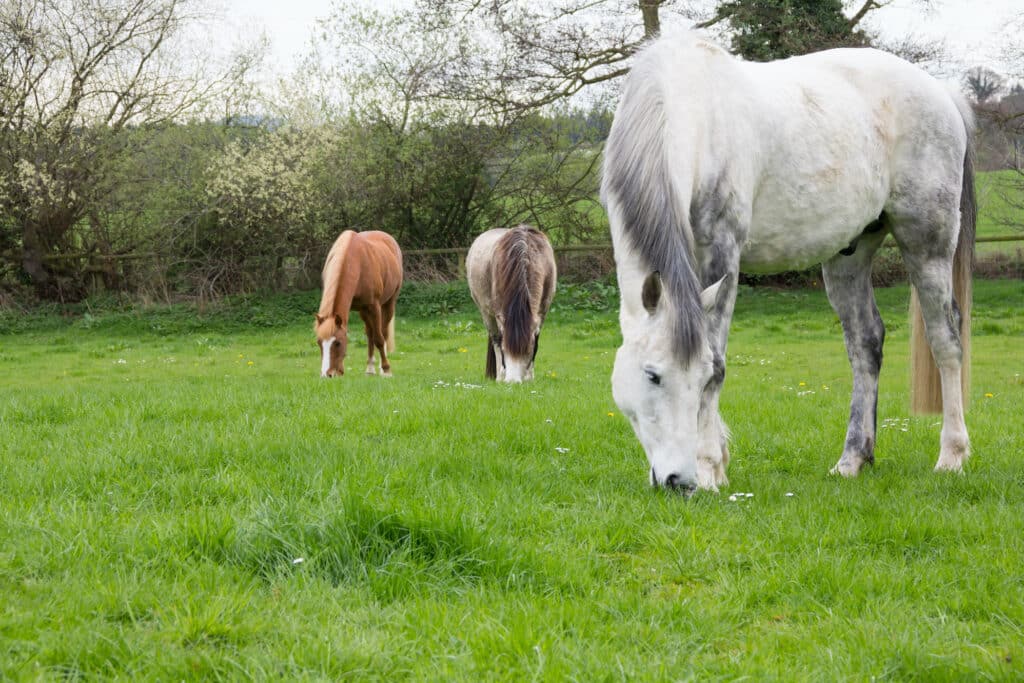Uncategorised
How does being fat affect your horse?
The Horse Hub talks to Alison Talbot, Senior Lecturer in Equine Orthopaedics at Liverpool University Equine Hospital about the effects of obesity in horses
Obesity in horses is a growing problem. While most horses in developed countries are used for pleasure or sporting purposes rather than work, it seems obesity is not exclusively a modern problem! The paintings of George Stubbs (18th century artist) show that cresty necks and round rumps were favoured then, as a sign of good condition. The difference being that in those days, the horses would have dropped off considerably during the winter when feed was more scarce.
Many of our modern management practices with good rugs and supplementary feeding, mean that during the colder weather, when horses would naturally utilise more energy to keep warm, there is now no natural dip in body condition that would be regained with the flush of spring grass.
In fact, if owners do allow their horses to become leaner coming out of winter, there are often questions asked regarding neglect – of course this is a fine line and, it is important to know the difference between a healthy weight loss and a welfare issue! Read more about how to recognise if your horse is fat here.

Fluctuating vs permanent obesity
The state of fluctuating vs permanent obesity is important when it comes to investigating why obesity is so dangerous. Positive energy balance results in the normal physiological process of fat deposition, whereas obesity is described as the pathological accumulation of fat, to the extent that there is a negative health effect (Rendle et al. 2018).
Body fat is not harmless!
Not only are there physical effects of the extra weight and space taken up by body fat but, the adipose tissue (body fat) itself can cause harmful hormonal and, inflammatory effects. If the body fat is permanent rather than seasonal, these effects are continuous not intermittent, putting additional strain on multiple areas of the body.
There also appears to be differences between horses and ponies, in that the adipose tissue of ponies seems to promote more inflammation, than that of horses (Blaue et al. 2020).
The potential effects of obesity on overall horse health are far ranging and include:
Metabolic syndrome
Obese horses are at greater risk of equine metabolic syndrome. Horses with equine metabolic syndrome are more likely to be fat. Insulin dysregulation (inability to regulate blood insulin levels) is at the centre of this syndrome. Not all horses with equine metabolic syndrome will appear outwardly fat but, they may have large fat deposits on the inside (fat on the inside thin on the outside).
If obese animals suddenly enter a negative calorie imbalance, for example if placed on a very restrictive diet or, if they suddenly stop eating due to sickness or injury, the body will rapidly resort to utilising fat, which can result in too many triglycerides (fatty acids) in the blood stream. This can overwhelm the capacity of the liver and, life threatening liver disease can result.
Laminitis
Obesity increases not only the risk of developing laminitis (Robin et al. 2015) but also decreases the prognosis for recovery from a laminitic episode (Menzies-Gow et al. 2010).
The biochemical processes causing a laminitic episode are complex, affecting pituitary function, insulin regulation and, triggering inflammation. This has a direct effect on the structure of the laminar cells in the hoof, which weakens and fails resulting in laminitis. The additional weight of the extra body fat further weakens the lamellae.
Orthopaedic conditions other than laminitis
Increasing fat in older horses has been shown to be directly associated with an increase in pro-inflammatory cytokines (molecules causing inflammation released by certain cells) in the blood, that are associated with inflammatory ageing changes (Adams 2009). When the same horses in that study were put on a restricted diet and body condition score reduced, there was a significant reduction in the amount of circulating pro- inflammatory cytokines.
Excess body weight puts an increased biomechanical strain on tendons, ligaments, and joints. This combined with the inflammatory effects of body fat, can make it difficult to treat and manage many orthopaedic conditions.
Further research is needed as to the extent to which increased body weight affects tendon and ligament strain, and osteoarthritis in the horse. In younger animals when the skeleton is still growing, obesity and excess calories are a risk factor for developmental orthopaedic disease.
The respiratory system
The physical effects of obesity can affect the upper and lower airways. Relative to total body mass – the mass of the respiratory tract may be reduced by as much as 15% (Dugdale et al. 2011).
Recently it has been shown that there maybe a link between body condition score, the structures at the back of the tongue and, fat accumulation within the tongue, which affects upper respiratory tract airflow. Work in this area is ongoing.
In the lower airway physical restriction decreases the expansion of the lungs (lung capacity). A recent study in the USA has also identified a link between equine asthma and increased body weight (Thomas et al. 2021).
Cardiovascular effects
Higher than average blood pressure has been identified along with high insulin in laminitis prone ponies (Bailey et al 2008).
 Behaviour
Behaviour
A Study from 2013 showed that the risk of misbehaviour in Pony Club ponies is higher in fatter ponies, in horses with access to pastures with greater green grass cover, in those fed daily supplements and in those receiving exercise less frequently (Buckley et al 2013).
Poor performance
A horse that is carrying too much weight will have to work harder to produce the same performance as a leaner equivalent.
This can result in a range of poor performance syndromes that are often overlooked or not considered, especially if the weight gain has been gradual and not fully appreciated by the owner of the horse.
The reproductive system
Fertility problems may also be linked to obesity in both mares and stallions, affecting not only fertility and libido in the stallion but, may also have long term effects on the offspring (Sessions-Bresnahan et al. 2018).
Colic
As horses age and fat deposits accumulate within the abdomen, benign fatty lipomas can develop. These tumours may exist for many years without problem but can cause sudden intestinal strangulation and severe colic. The level of risk in relation to the length of time of obesity and the level of obesity is not yet known.
There are probably many more negative effects of obesity on the horse than those mentioned above and, studies into this are ongoing worldwide, which ultimately, will improve the welfare of horses.
REFERENCES
Bailey SR; Habershon-Butcher JL; Ransom KJ; Elliott J; Menzies-Gow NJ(2008): Hypertension and insulin resistance in a mixed-breed population of ponies predisposed to laminitis. Am J Vet Res. 69; 122-9.
Buckley P; Morton JM; Buckley DJ; Coleman GT(2013): Misbehaviour in Pony Club horses: Incidence and risk factors. Equine Vet J. 45, 1. 9-14.
Blaue D; Schedlbauer C; Starzonek J; Gittel C; Brehm W; Bluher M, Pfeffer M, and Vervuert I (2020): The influence of equine body weight gain on inflammatory cytokine expressions of adipose tissue in response to endotoxin challenge. Domest Anim Endocrinol; 68; 111-118.
Dugdale A H, Curtis GC, Harris PA, Argo CM. (2011): Relationships between the anatomical distribution of adipose tissue, body composition and body condition. Equine Vet J. 43: 552-61.
Menzies-Gow NJ; Stevens K; Barr A; Camm I; Pfeiffer D; Marr CM (2010): Severity and outcome of equine pasture-associated laminitis managed in first opinion practice in the UK; Vet Record; 167, 10, 364-369.
Rendle D; McGregor Argo C; Bowen M; Carslake H; German A; Harris P; Knowles E; Menzies-Gow N; Morgan R (2018): Equine Obesity: Current Perspectives Roundtable: UK -Vet Equine; 2; Sup 5.
Robin CA; Ireland JL; Wylie CE; Collins SN; Verheyen KLP; Newton JR (2015): Prevalence of and risk factors for equine obesity in Great Britain based on owner-reported body condition scores. Equine Vet J. 47; 2; 196-201.
Sessions-Bresnahan DR; Heuberger AL; Carnevale EM (2018): Obesity in mares promotes uterine inflammation and alters embryo lipid fingerprints and homeostasis. Biology of Reproduction, 99, 4, 761–772.
Thomas SJ; Navas de Solis C; Coleman MC (2021): Case-Control Study of Risk Factors for Equine Asthma in Texas. J Eq Vet Sci; 103.

 Behaviour
Behaviour